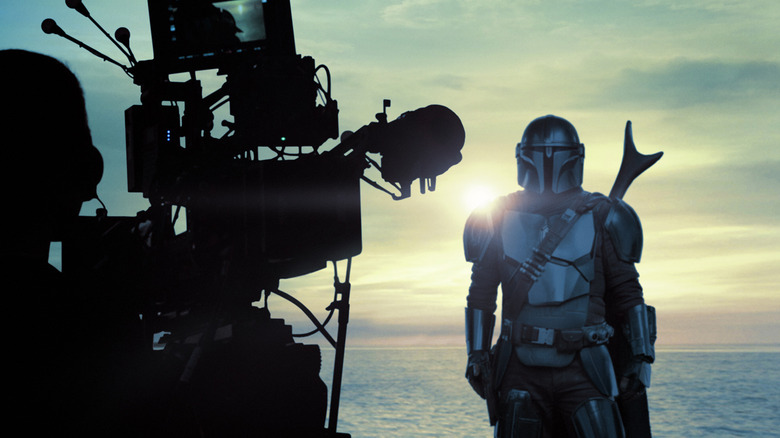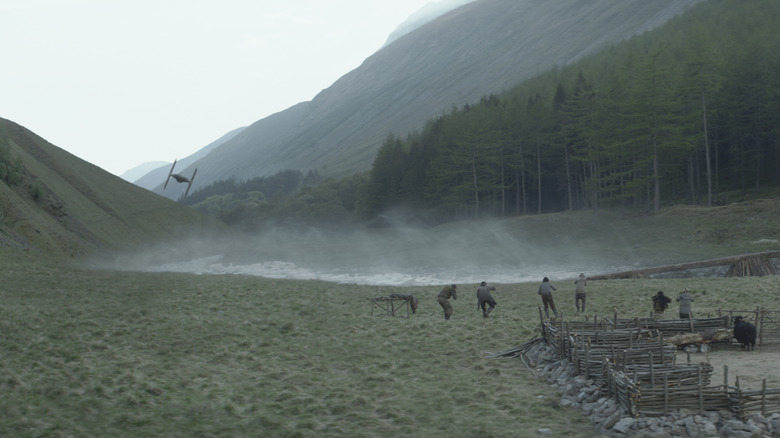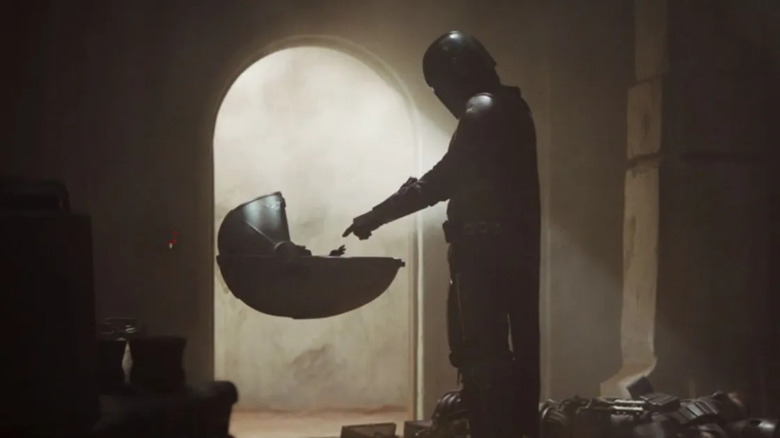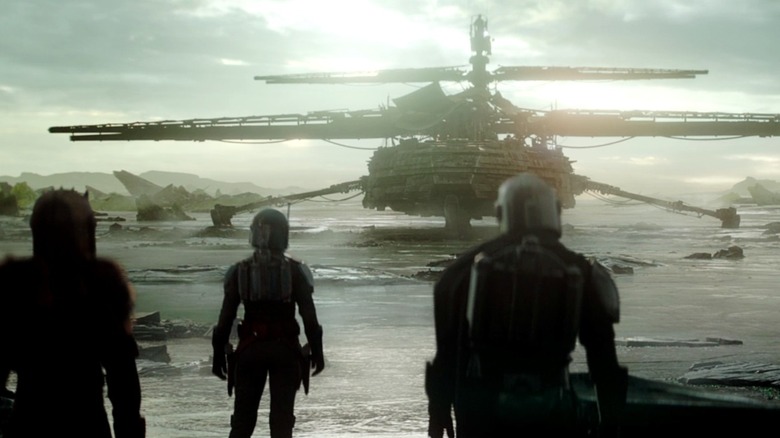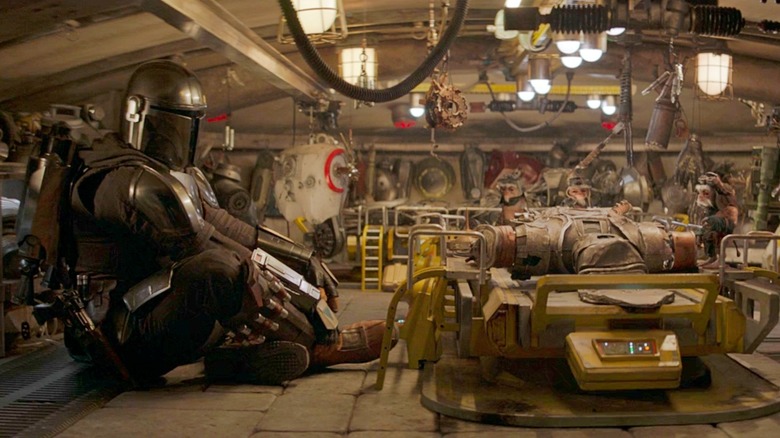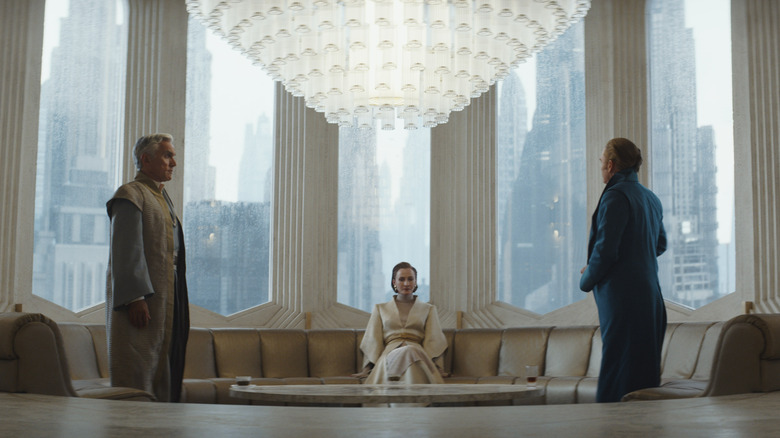Andor Vs. The Mandalorian: The True Limitations Of Filming In The Volume
When it was first unveiled as an integral ingredient in "The Mandalorian," StageCraft made a lot of jaws drop. Developed by Industrial Light & Magic, the concept of a sound stage surrounded with dynamic, high-definition LED backgrounds — a set-up referred to as the Volume — was a modern-day answer to old-school matte paintings. It gives actors something to look at besides mind-numbing blue and green walls, functions dually as a light source that matches the needs of the scene, and can convincingly simulate the experience of flying a ship through the vastness of space. The "Star Wars" prequel trilogy in particular had been blasted by fans for its overuse of green screens; StageCraft seemed like the ultimate solution.
At this year's Star Wars Celebration, Doug Chiang — veteran "Star Wars" production designer, and executive creative director of Lucasfilm — enthused about the Volume's role in "Obi-Wan Kenobi" and "The Mandalorian" season 3. "We only physically built the floor and the foreground set pieces like the tables in the markets," he revealed as he shared behind-the-scenes photos of the stage floor, which is only 40 feet by 70 feet. "And yet," Chiang continued, "the city streets looked like they were hundreds of feet long, and the buildings hundreds of feet tall."
A few years ago, these images might have sparked mutterings of awe, perhaps even some applause. At Celebration 2023, they were met with a palpable silence. After audiences were told how the magic trick of the Volume worked, suddenly it became hard not to see the strings: the way that many scenes in "Star Wars" shows looked hemmed-in, the actors restricted to an area not much bigger than a theater stage. And when "Andor" premiered just a few months after the conclusion of "Obi-Wan Kenobi," it showed us what was missing.
A return to the real world
In stark contrast to "Obi-Wan Kenobi" and "The Mandalorian," which were largely filmed on the Volume stage at Manhattan Beach Studios, much of what we see in "Andor" was captured on location. The day before Doug Chiang's presentation, a panel exploring the visual effects of "Andor" revealed that roughly 80% of what's on screen in the Aldhani arc (episodes 4-6) is pure, unfiltered Scottish landscape; the shot above was captured in Glen Tilt, Perthshire. Even the Imperial supply hub where the heist mission takes place is real: Cruachan Dam, in Argyll and Bute, which coincidentally bears a resemblance to Darth Vader's mask.
Okay, so the rural highlands might be a serviceable shooting location for scenes set on a largely untouched planet — but what about a fantastical sci-fi ecumenopolis like Coruscant? Well, that's where the location work in "Andor" gets really interesting, because there are plenty of existing locations in the U.K. that already look right at home in science fiction. Among them is Canary Wharf Underground station in London, which previously played the role of an Imperial base in "Rogue One," and returned as the setting for the Imperial Security Bureau headquarters in "Andor." Syril Karn's miserable homecoming after his failed mission on Ferrix takes him from a Coruscant spaceport (the McLaren Technology Centre in Woking) to the stark, brutalist architecture of his mother's apartment building (the Brunswick Centre in the London borough of Camden).
But perhaps the most charming location in "Andor" season 1 is the English seaside town of Cleveleys, which barely needed a makeover to become the tropical resort planet of Niamos. A change of doors turned the Cove Café into a "Star Wars" cantina, and the funky architecture of the seafront promenade seemed almost purpose-built for a sci-fi location.
The spoiler problem
Before diving into a sermon about how "Obi-Wan Kenobi" and "The Mandalorian" should have been shot on location like "Andor" was, it's important to acknowledge why they weren't. It's true that "Andor" showrunner Tony Gilroy was strongly committed to filming on location as much as possible, but it's equally true that "Andor" didn't risk much by doing so. The biggest spoiler for Cassian Andor's story was already dropped at the end of "Rogue One," and besides Mon Mothma (whose future is also known), the series doesn't really have any legacy characters from the "Star Wars" movies. By design, "Andor" is a show about the unsung heroes of the Rebellion, so it would be pretty off-brand to have Luke Skywalker or Leia Organa suddenly pop up.
All of which is to say that "Andor" doesn't have much to fear from the fans and paparazzi who inevitably pop up around the edges of any location shoot. Even with filming permits and a perimeter set up, there's a limit to how far away members of the general public can be kept. For a recent example, look no further than the filming of "Joker: Folie à Deux" in New York City, where a cornucopia of candid set photos have already shown Joaquin Phoenix and Lady Gaga clowning it up.
There was a huge advantage to filming the majority of "The Mandalorian" on the Volume stage: the Child (aka Baby Yoda, aka Grogu) was effectively kept secret until the series premiere dropped — a surprise that instantly lit a fire under the series, and a relationship that became its driving force. Similarly, Vivien Lyra Blair's adorable miniature Princess Leia was kept hidden until "Obi-Wan Kenobi" arrived on Disney+. Had these shows shot on location, a single stray set photo would have been enough to have "Baby Yoda?!" and "Young Princess Leia!!" headlines all over the internet a year before they even premiered. Those surprises are important to Lucasfilm; Ian McDiarmid had to be smuggled into the studio under umbrellas to conceal Palpatine's presence in "The Rise of Skywalker," and Blair didn't even learn the code name for the character she'd be playing until somewhere around her seventh audition.
Making space feel small
The Volume might be perfect for protecting secrets, but it has its limitations. In one particularly egregious moment in the penultimate episode of "The Mandalorian" season 3, Din Djarin, Bo-Katan, and the other Mandalorians arrive on the blasted surface of Mandalore and (supposedly) walk for some distance. However, it is painfully clear when they arrive at their destination that it's the same set they were just standing on, with some of the rocks moved around (and indeed, the same bit of ground that Din landed his ship on back in episode 2, "The Mines of Mandalore"). Perhaps this would be less obvious to a viewer not already aware of the Volume stage and its modest dimensions, but there are creative drawbacks to actors not being able to walk more than a handful of steps in any direction.
The galaxy depicted in "Obi-Wan Kenobi" and "The Mandalorian" feels distinctly less tangible than the one where we saw Cassian and Vel scrambling over a hillside on Aldhani, and then flattening themselves against a rock at the sound of an approaching TIE fighter. That scene took one of the most familiar ship designs in the "Star Wars" universe and made it feel shocking and threatening again; an alien object in the vast highland landscape. (There's a certain poetry, too, in using a Scottish location to tell a story about indigenous people seeing an Imperial war machine taking over their land.)
"Scotland's like our desert," said production designer Luke Hall at Star Wars Celebration. "We wanted something where the landscape was a big part of that story and opening up at that point in the story." Tony Gilroy explained that he wrote the show around the locations, and having a clear vision of the space in mind was essential to putting the story and action together: "I can't do anything if I don't know where I am."
Embracing the limitiations
As mentioned above, suggesting that all "Star Wars" shows should simply follow the example set by "Andor" overlooks the risks of filming on location when it comes to protecting spoilers, not to mention all the other downsides (including but not limited to: bad weather, unpredictable lighting, filming permits, travel and accommodations costs for an entire cast and crew, grumpy locals, and having to pause takes because a noisy plane is passing overhead). Equally, building lots of vast sets from scratch is not particularly feasible on a TV budget — even a relatively lavish one.
What Lucasfilm can do, however, is recognize the Volume's strengths and weaknesses: be more selective about which scenes utilize the limited space, and perhaps even lean into its stage production qualities. It's well-documented in filmmaking that constraints breed creativity; Joe Wright's adaptation of "Anna Karenina" was memorably staged around a single theater set, with furniture and walls being moved around in choreographed scene transitions. One of the best sets in "The Mandalorian" season 3 — the Anzellan workshop on Navarro, with ceilings so low that Din Djarin is forced to sit cross-legged on the floor — thrives on the smallness of the space.
The Volume has, however, proven to be an unconvincing substitute for real-world landscapes. In a behind-the-scenes video for "The Mandalorian" season 1, Epic Games CTO Jim Libreri showcases the live geometry sculpting offered by the Volume, saying, "If you want to move a mountain from there to there, you can do it instantly." The landscape of Tunisia couldn't be sculpted in the same way when George Lucas was filming "A New Hope" back in 1977, but it was crucial to making Tatooine feel like a real place before Luke Skywalker left home to go on his adventures through the galaxy.
With regards to the spoiler problem, it is possible to find locations away from the prying eyes of the public; Skellig Michael, the small island off the coast of Ireland that played the role of Ahch-To in the sequel trilogy, was a great location. And the black, volcanic sands and strange dramatic vistas of Iceland have frequently been visited in sci-fi films, from "Rogue One" to "Oblivion" to "Prometheus."
The right tool for the job
Though "Andor" writer Tony Gilroy initially said that the Volume wasn't used for the series, this isn't entirely true. At Star Wars Celebration, the VFX team highlighted some of the scenes where the state-of-the-art StageCraft technology had been implemented — such as the Chandrilan Embassy on Coruscant, where the LED backdrop was used to create the city landscape seen through the grand windows framing the room. Talking about the scrutiny that the Volume had been placed under, visual effects supervisor Mohen Leo commented:
"It's funny because it almost became sort of a talking point. 'Did you use the Volume? Did you not use the Volume?' And it was really not, at any point, a question of philosophically we do or don't want to [use] it. It was just much more like, what is the right solution? This worked absolutely beautifully for what we needed, and it was actually a testament to how flexible StageCraft is that it can adapt to the different [needs].
The "Mandalorian" season 3 finale exemplifies what StageCraft can achieve when it's the right tool for the job. The final fight staged in the Imperial base on Mandalore, culminating in an Imperial cruiser crashing into the structure, would have been seriously challenging to find a real-world location for, and certainly wouldn't have looked as good if it had been shot in front of a green screen. Elsewhere on Mandalore, though, the reliance on the Volume made it difficult to connect to the Mandalorian homeworld in the same way that Ferrix and Aldhani felt like real places.
The temptation of the Volume is understandable: in theory, the technology can recreate just about any environment. But just like having a real puppet on set allowed audiences to connect with Grogu in a way they probably wouldn't have connected with a wholly CGI creation, "The Mandalorian" season 4 might benefit from putting Din Djarin's boots on solid ground every once in a while.
